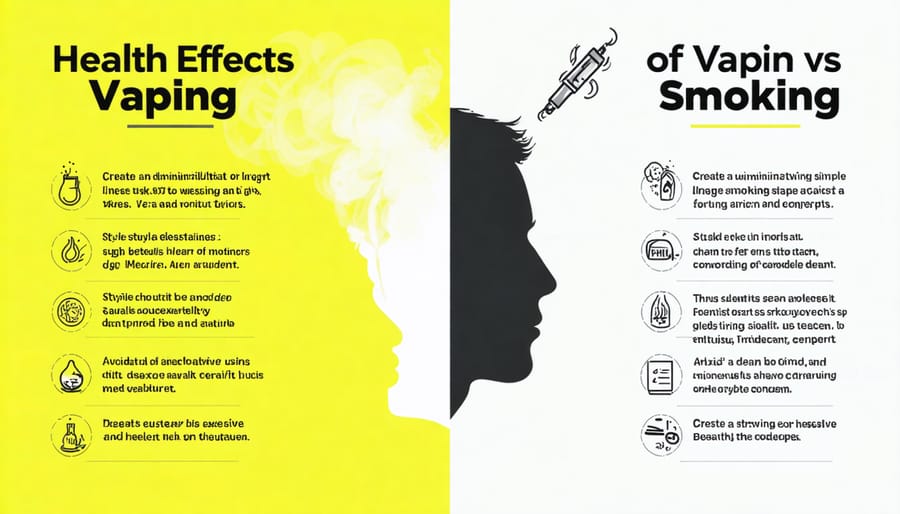Visit vape shop sainte catherine to understand retailer perspectives on regulation. Assess health regulations globally by comparing effective policies that have improved public health outcomes in various regions. Tailor local regulations to discourage youth access by enforcing age verification at purchase points. Encourage collaborative policy-making among government, health experts, and retailers, ensuring regulations are both effective and practical. Review scientific findings regularly to stay informed about vaping’s health impacts and adjust policies accordingly.

The State of Vaping Regulation: A Global Perspective
United States Regulation Trends
The United States has a complex framework for vaping regulation that is continually evolving to balance public health interests and individual freedoms. Following the 2019 spike in vaping-related lung injuries, federal and state authorities intensified efforts to control the market. At the federal level, the FDA regulates e-cigarettes as tobacco products, mandating premarket reviews and setting age limits for purchase. Recent actions include limiting flavored vape products to prevent youth access, a move somewhat parallel to Canada’s New Regulation. States are also active; many have imposed additional restrictions such as higher excise taxes, public indoor vaping bans, and flavor-specific prohibitions. These measures aim to curtail youth usage while considering adult smokers seeking harm reduction alternatives. As the regulatory landscape shifts, collaborative policymaking that embraces scientific evidence and a balanced understanding of vaping’s risks and benefits remains crucial. This evolving framework seeks to reduce smoking-related harms without discouraging smoking cessation efforts.
Europe’s Evolving Policies
The European Union (EU) adopts a precautionary principle in regulating vaping products, aiming to protect public health amidst uncertainty about long-term effects. By implementing stringent measures like age restrictions, advertising bans, and product safety standards, the EU seeks to minimize potential harms while acknowledging vaping as a less harmful alternative to traditional smoking. This balanced approach reflects a growing consensus among European policymakers to prioritize health outcomes while addressing smoking-related risks.
Evidence-based policy formulation is crucial in the EU’s approach. Studies indicate a positive shift in smoking cessation rates due to vaping, suggesting potential public health benefits. However, concerns about youth uptake and long-term health implications persist, necessitating ongoing research and adaptation of regulations. Collaborative efforts among EU member states foster uniformity in policy execution, ensuring that regulations are both effective and adaptable to new scientific findings. This evolving framework reveals the EU’s commitment to reducing smoking prevalence and enhancing public health outcomes without inadvertently promoting vaping as a smoking entry point.
Emerging Markets in Asia and Beyond
Emerging markets in Asia and beyond are navigating complex vaping regulation landscapes, balancing potential health benefits with significant challenges. Countries like India and Indonesia are dealing with high smoking rates, presenting vaping as a potential harm reduction tool. However, these nations face hurdles such as limited regulatory infrastructure and varying levels of public health awareness. Policymakers in these regions are often caught between global industry pressures and public health advocacy, striving to create regulations that deter youth usage, align with scientific evidence, and consider cultural norms.
The different approaches range from total bans, as seen in some Indian states, to more nuanced regulatory frameworks aimed at controlling manufacturing standards and advertising. Collaboration between governments, health organizations, and industry stakeholders is essential to address the lack of resources and expertise. Constructive policy strategies involve educational campaigns and data-driven assessments of health outcomes. Sharing best practices from countries with established regulations could support these emerging markets in fostering safer environments while respecting their unique socio-economic dynamics and cultural values.
Health Outcomes: What Does the Research Say?
Short-term vs Long-term Health Effects
Vaping has been promoted as a less harmful alternative to smoking, but understanding its health implications is crucial for making informed decisions. In the short term, some users report experiencing side effects like coughing, dry mouth, and throat irritation due to vaping. These symptoms can be attributed to the inhalation of vaporized substances and may vary depending on individual sensitivity and usage habits. Despite these immediate effects, one of the major concerns is the potential for nicotine addiction, as many e-liquids contain this addictive substance, although users can find resources on safe vaping practices.
In contrast, long-term health effects are still being extensively studied. Emerging evidence suggests potential risks related to lung and cardiovascular health, echoing concerns similar to those already established for traditional smoking. However, notable differences exist in the chemical constituents between combustible cigarettes and e-cigarettes, warranting a more nuanced understanding of their impacts. The long-term consequences remain uncertain but emphasize the necessity for ongoing research and thoughtful regulation. A balanced policy approach, considering both immediate and possible long-term health outcomes, is vital. Such regulation should aim to minimize harms while recognizing vaping’s role in harm reduction for current adult smokers. This nuanced strategy could ultimately support public health goals without encouraging nicotine initiation among non-smokers.
Comparative Risks: Vaping vs. Smoking
Vaping and traditional smoking are often compared in discussions about health risks and benefits. While both activities involve inhaling substances into the lungs, the key difference lies in what is being inhaled. Traditional cigarettes contain tobacco, which, when burned, releases over 7,000 chemicals, many of which are toxic and carcinogenic. In contrast, e-cigarettes heat a liquid containing nicotine, flavorings, and other chemicals, producing a vapor instead of smoke. This process eliminates many harmful byproducts of combustion present in tobacco smoke.
Research indicates that vaping may pose fewer health risks than smoking. For instance, studies have shown reduced exposure to harmful chemicals among vapers compared to smokers, suggesting a potential for reduced risk of smoking-related diseases. However, vaping is not without its risks. Concerns remain about the long-term health effects due to inhaled chemicals in e-liquids, and nicotine addiction persists as a significant concern for both vapers and smokers.
Understanding these comparative risks is crucial for informed decision-making and public policy. Clear regulatory frameworks can help minimize potential harms by ensuring product safety and restricting access to vulnerable populations. Collaborative efforts between health organizations and policymakers can guide balanced regulations that protect public health while acknowledging vaping as a possible harm reduction tool for current smokers seeking alternatives.


Policy Suggestions: Bridging the Gap Between Regulation and Health
Encouraging Harm Reduction
Achieving a reduction in smoking rates requires innovative approaches that take into account the role of vaping as a potential harm reduction tool. Effective policies should aim to strike a balance between encouraging smokers to switch to less harmful alternatives and ensuring that vaping products do not become a gateway for non-smokers, particularly youth. Policymakers can explore strategies like regulating nicotine content, enforcing marketing restrictions, and implementing robust age verification processes to minimize risks while maximizing benefits.
Research indicates that adult smokers who switch to vaping may experience improved health outcomes compared to continued smoking, suggesting that vaping could play a pivotal role in public health strategies. Therefore, fostering collaboration among health professionals, vape retailers, and regulators is crucial to create informed policies. Transparent, evidence-based regulations can lead to safer product use and reduced smoking prevalence, aligning with global public health goals. By prioritizing harm reduction, stakeholders can create a responsible vaping framework that supports adult smokers in their journey to quit traditional cigarettes, ultimately contributing to better health outcomes on a broader scale.
Ensuring Youth Prevention
To effectively prevent minors from accessing vaping products while maintaining harm reduction benefits for adults, a multifaceted strategy is essential. Implementing stringent age verification processes at point-of-sale is crucial. Retailers should receive training on age-check procedures and the consequences of non-compliance. Complementing these measures, policymakers must consider the impact of regulations such as the vape flavors ban, which while aimed at reducing youth appeal, might inadvertently affect adults seeking safer alternatives to smoking. Collaborative efforts between public health officials and educational institutions can raise awareness about vaping risks among youth, encouraging informed choices. Furthermore, e-commerce platforms should employ robust age verification technologies to prevent online access to minors. Enforcement of existing laws through regular compliance checks and penalties for violations can deter unlawful sales. These combined approaches will not only protect young people but also support adults in reducing smoking-related harms, aligning with the mission to prioritize public health while respecting individual choices for safer alternatives.
The Role of Electronic Cigarette Retailers in Regulation and Health
Electronic cigarette retailers hold a crucial position in shaping healthier public outcomes through thoughtful engagement with regulation and responsible marketing practices. By adhering to and promoting existing guidelines, these retailers can play a significant role in reducing smoking-related harms. A primary step involves partnering with policymakers to ensure that marketing strategies do not target youth but rather focus on the benefits for adult smokers seeking alternatives. This collaboration can be furthered by providing feedback to regulators on the effectiveness of certain policies, thereby contributing valuable real-world insights into crafting better regulations.
Retailers can also engage in educational initiatives aimed at adult consumers, ensuring they are informed about the potential risks and benefits of vaping. By providing detailed, unbiased information, consumers are empowered to make well-informed decisions about their health. Furthermore, retailers could contribute by advocating for clear labeling of nicotine levels and other ingredients, promoting transparency and safety in their products.
In addition, establishing in-store policies that rigorously verify age and discourage sales to non-smokers can substantially aid in minimizing youth access, aligning with broader public health goals. Through training programs, retailers can ensure their staff are knowledgeable about regulatory compliance and can communicate this effectively to consumers.
Ultimately, by embracing a proactive stance in compliance and collaboration, electronic cigarette retailers can significantly influence the landscape of vaping regulation. Such efforts can help in striking a balance between providing adult smokers with viable alternatives and safeguarding public health, thus contributing positively to the community’s overall health outcomes.
Conclusion
Vaping regulation plays a crucial role in shaping health outcomes and requires a balanced approach to effectively serve adults concerned about smoking risks. The intricate relationship between regulation and health is evident as policies can both reduce harm and inadvertently lead to unintended consequences. Evidence shows that sensible regulation helps mitigate the risks associated with vaping while promoting harm reduction strategies for current smokers. For instance, when individuals turn to alternatives like vaping CBD, they often seek to cut down on traditional smoking for hopefully improved health outcomes.
A clear, informed regulatory framework can ensure product safety, prevent youth access, and support harm reduction among adult smokers. Furthermore, the collaborative efforts of policymakers, health experts, and the vaping industry must focus on unbiased risk-benefit analyses, facilitating informed decisions that prioritize public health without stifling innovation. Ultimately, the goal is to create an environment where adults can make health-conscious choices while minimizing potential risks associated with vaping. This approach underscores the importance of regulations that are not only evidence-based but also adaptive to evolving scientific findings and public needs, ensuring that health remains at the forefront of policy discussions.
